Top ratings
Get free trial access now Try first, then study!

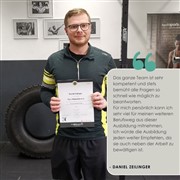
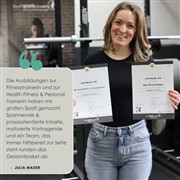

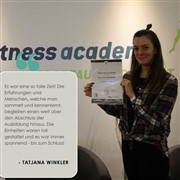



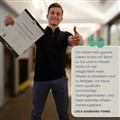
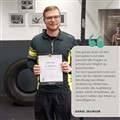
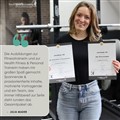
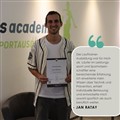

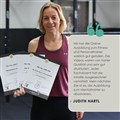
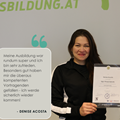
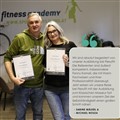

€ 1.790,- | Classroom Courses
» Our Course Packages
Important informations
Recognized & Certified
Our graduates, partners & friends say
Our team will be happy to advise you at any time by phone, chat or in person
Do you love sport and want to inspire others? Our fitness trainer course will lay the foundations for a successful future in the fitness and health industry.
Whether you want to work in a gym, get started as a personal trainer or set up your own business - with your trainer license , many doors are open to you.
You decide how you would like to complete your training: flexibly in online distance learning or practically in a face-to-face course. As a TÜV-certified training institute, we guarantee you the highest quality, sound content and personal support from experienced instructors.
This means you can not only take your own training to the next level, but also professionally support and motivate other people. Start your training now and turn your passion for fitness into your profession.
Extent of learning
598 E
EQF level
The training is based on EQF level 4 »
Course start
Possible immediately
Learning variant
Classroom Courses

| 29-12-2025 | € 1.790,-
| 12-01-2026 | € 1.790,-
| 12-01-2026 | € 1.790,-
| 29-12-2025 | € 1.790,-

Our fitness trainer training in Austria opens up a wide range of opportunities in the fitness and health industry. You will learn how to convey training content in an understandable way and support people in achieving their sporting goals.
During the course, you will acquire in-depth knowledge of anatomy, training theory and nutritional principles. You will practise how to create training concepts, provide individual customer care and successfully apply various training methods.
In addition to the online fitness trainer training, you also have the opportunity to deepen your knowledge in person - at our locations in Vienna, Linz, Graz and Innsbruck. There you will benefit from direct support from experienced lecturers and gain valuable practical experience.
We offer our fitness trainer training courses in Austria and are represented at several locations: Vienna, Linz, Graz and Innsbruck. This gives you the opportunity to complete your training in your local area and benefit from professional on-site support at the same time. Whether you want to take the first step in your career as a fitness trainer or are already working in the sports sector and want to continue your education - our fitness trainer training courses in Vienna, Linz, Graz and Innsbruck open up the best opportunities for your professional future.
Upon successful completion, you will receive your trainer license - your door opener for fitness studios, clubs or self-employment as a fitness trainer.
You don't need any special sporting qualifications to start the fitness trainer course in Austria; the most important thing is your enthusiasm for exercise and the joy of working with people. Our instructors will guide you step by step and ensure that you receive sound, practical training.
After successful completion, you will receive your recognized certificate of completion. This certificate is valid worldwide. Our certificates are available in different versions. Depending on the learning package, you can choose whether with or without grading. Country-specific information is also available.
Extent of learning
200
Sports expertise
315
Presence | Self-study
12
Literature research
60
Practical realization
11
Additional tasks & examinations
Our training courses are generally eligible for funding. The relevant funding body will decide whether you are eligible for funding.
We will be happy to support you in compiling all the necessary course information you need for your funding application.
Of course, we will be on hand to advise you throughout the entire process and support you from the initial inquiry to the submission of your application. Contact us - we will make sure that you are as well prepared as possible!
Show all chapters of the subjects

We educate the best trainers in the fitness branch. From start to finish of the education - and beyond!- we support and guide our students.
Functional anatomy is a foundation necessary for all trainers in exercise, fitness and sports. This subject provides a comprehensive introduction to the anatomy of the human body and a wellspring of important knowledge.
The course is constructed to present the information in an interesting and comprehensible manner and features different learning approaches appropriate for Fitness and Personal Trainers.
The goal is, to understand the relationship between movement patterns, the human body and relevant anatomical terminology.

Our participants are introduced to the basics of sports nutrition.
As a foundation the composition of general nutrition including macro and micro nutrients, as well as the water balance, are discussed. In order to understand various correlations, the energy metabolism are explained in detail.
In addition, the effects of individual food components in the human body, as well as their importance in sports are covered.


More and more companies are integrating Corporate Wellness and similar health initiatives into their employee benefits packages. By doing so they promote the health and well-being of their employees, reducing the incidence of sick-leave and building healthier, stronger team dynamics.
Exactly why such initiatives are important is discussed in this introduction to the concept, as well as challenges that such initiatives face including organisational dysfunction.
Participants also learn about the advantages of corporate wellness and some trusted approaches and tools for finding and working with a company.
We offer suggestions on how to approach companies about Corporate Wellness, how to develop a corporate wellness concept and important organisational points to consider.
Participants will be exposed to some practical examples and will have the possiblity to perform group work on the topic.

The unit on Marketing and Customer Interaction gives participants some insight into identifying, working with and marketing to their ideal customer. This is one of the most useful units for the aspiring trainer, as it helps them identify their place in the market, which makes for a more successful career start.
We begin by taking a look at Marketing itself to understand exactly what it is and of what relevance it has for personal trainers.
Important basic concepts such as USP, positioning, target market, etc. are introduced and different models from marketing such as the SMART Formula, marketing mix (7Ps) and more are explained.
The communication between trainer and client is also addressed in this unit. Various aspects of communication theory and some guidelines for successful communication are covered.
Upon completion of this subject, participants are able to develop marketing strategies for their product and/or services, ready to position themselves in a market rich in variety and full of possibility!

A working understanding of human physiology and therefore the relationships between the various functions of the human body is crucial for anyone working in the exercise and fitness field. It is a requisite knowledge for the sufficient practice of their profession.
This course makes the relationships within the human organism graspable for everyone. Take a deep-dive into the human body and learn the functions of our organism for your new profession in fitness.
In this subject you will get a close look at energy metabolism needed for muscle activation, the circulatory system and the pulmonary system.
Any high quality education in fitness and exercise begins with the foundations of anatomy and physiology.

In this unit participants are prepared for successful communication with their clients on every level. In addition, we take a look at how the trainer or coach can go about dealing with their own goals and motives, which will in turn help them better understand their clients.
The right goal-setting and the proper approach to feedback are an important parts of this unit.
The way we manage stress as trainers and with our clients and a variety of learning strategies are explored so these skills can be integrated into your professional approach.

The first part of training theory teaches the basics of training, such as training principles, principles of training design, training methods and the factors of athletic performance.
As performance, performance diagnostics, training and competition are closely interrelated, they are also taught accordingly in the course.
In the second part of training theory, training is defined and evaluated as a complex action process and in connection with planning, execution and evaluation.
An important part of training theory is still the design of training plans, which is taught in practice with examples of the possibilities of designing a training plan.
In order to delve even deeper into training science, we have worked with top international speakers such as Prof. em. Dr. phil. Dr. med. Dr. h.c. Jürgen Weineck, we have also developed a video workshop on the subject of altitude training.
Show all chapters of the subjects

Alongside strength training, endurance training is an important basis for good performance in any sport and also has many positive, health-promoting effects. The better your endurance is trained, the longer you can achieve a certain performance.
However, endurance does not necessarily mean running as far as possible as quickly as possible. Rather, it is about training your endurance in such a way that you can work at a certain intensity for as long as possible. This intensity depends on the sport in question.
In the endurance training course, participants learn the theoretical content of how intensive/extensive interval training, running, extensive and intensive endurance methods work. In practice, the UKK walking test is carried out, which is ideal for your future clients who are just starting out with training.
Additional emphasis is placed on training planning. During the practical training sections, the knowledge acquired is applied in practice. Graduates will be able to carry out and plan endurance training sessions independently.
Above all, they should be able to competently answer their customers' questions such as "At what heart rate can/should I train?
Another important subject in the fitness trainer course.

The human body is a complex system of muscles, tendons, joints and bones that is constantly in motion. Every movement we make triggers a reaction that affects other areas of the body.
Sensorimotor training is a method that trains precisely these reaction chains in the body. Targeted training of the senses (e.g. sense of balance, touch, sight and hearing) and motor skills (muscle strength, coordination, mobility) improves the interaction between body and mind.
What is sensorimotor training?
Sensorimotor training is a method that originates from the field of physiotherapy. Sensorimotor regulation is the brain's ability to control motor skills and perception. Sensorimotor training can optimize movement sequences and improve motor skills. It is used in physiotherapy for neurological disorders, such as after a stroke.
However, sensorimotor training can also be used in competitive sport and fitness to improve motor skills.
This content is therefore developed in the sensorimotor training course for fitness trainers, in which participants perform practice-oriented strengthening exercises using unstable surfaces such as wobble boards, foam, exercise balls, ropes or slings and much more.
The unstable surfaces train proprioception, i.e. the perception of one's own body and its movements. The exercises challenge balance, coordination and strength and are therefore particularly effective.

When we talk about strength training, most people immediately think of heavy weights and huge muscles. But that's not the only thing strength training has to offer.
Free weight training is used particularly in bodybuilding, weight training and martial arts as well as in rehabilitation after injuries. It is an effective and versatile training method that is suitable for both beginners and advanced athletes.
In contrast to strength training with machines, free weight training has the advantage that it also works the core and stabilization muscles. This makes it a more comprehensive workout because they enable us to hold our body upright and coordinate our movements.
They are also involved in many everyday movements, such as lifting objects or climbing stairs.
In this practical unit for fitness trainer training, course participants learn how to use dumbbells, barbells and pulleys correctly. Various exercises are demonstrated and performed by the participants themselves and particular attention is paid to joint-friendly execution with minimal risk of injury.

Functional Training refers to an approach to strength training that incorporates multiple muscle groups, movement patterns that reflect real human movement in the real world and place a high value on core musculature involvement in training exercises.
Multiple muscles are trainined at once, usually with a focus on entire muscle chains, in order to improve coordination between muscle groups alongside strength. Creating more stable and economical movement patterns that use the entire range of motion and strengthen the core are major goals.
Functional Strength Training is especially important because we want our clients and athletes to be able to use acquired strength for everyday movements and activity, or for the complex movement patterns necessary for any sport. This type of training is also appropriate for any age group and has applications in almost every type of sport, leisure activity, rehabilitation and injury prevention.
Some functional training methods utilize balance-challenging techniques and tools, small equipment that requires more core involvement for traditional movements, like medicine balls, sandbags and aquabags, or simply rely on bodyweight exercises.
In this course subject participants will learn about various training tools such as sling/TRX, gymnastics/balance ball, medicine and slam balls, sandbags, heavy/battle ropes and more. Bodyweight exercises are also a foundation of functional training, as certain bodyweight exercises can be used to expose functional weakness in even very "well-trained" athletes, and in order to build these abilities from the ground up. Muscle chains and some exercises which can be used to focus on specific ones are introduced.

The subject "Equipment-assisted strength training" is part of the fitness trainer B license training and deals with systematic strength training on stationary training equipment. The focus is on movement control, load control and the individual adaptation of training to different target groups.
In equipment-supported strength training, the muscles are loaded via mechanically guided movement paths. This enables targeted, controlled strain on individual muscle groups and offers a safe form of training, particularly for beginners, people with restricted mobility or in a rehabilitative context.
The following topics are covered as part of the course:
The content of this subject forms a basis for practical work in fitness studios or health facilities. Graduates are able to create and instruct individual training programs with equipment and implement them in a safety-conscious manner.

Full-body exercises are essential when it comes to training the entire body. Deadlifts, squats and bent-over rows are three of the most important full-body exercises there are. These said exercises can shape the body, improve overall well-being and are therefore essential for a fitness trainer. They also help to increase endurance and strength.
This subject is important because it teaches you the basics you need for all other types of exercises and workouts. Many focus on training individual muscle groups, but this is not the most effective way to get your body in shape. Full body exercises are more effective because they target multiple muscle groups simultaneously, making the workout more efficient. However, these exercises are very demanding and prone to mistakes.
For this reason, we provide our future fitness trainers with detailed instructions so that they can perform the exercises correctly and later instruct their clients well. The subject is very practice-oriented and is coached and worked on together within the group after a short introduction. Each exercise is designed to address a variety of muscle groups.

Training planning is an essential part of the work of a fitness trainer and personal trainer. In order to achieve efficient progress in your clients' training and to achieve long-term success, there are a number of important factors to consider. Regardless of whether the client's personal goal is to improve performance, reduce body fat, learn new, complex exercises or something else.
A few important basic principles are the Weineck training principles. These state, among other things, that a training stimulus must be sufficiently high in order to achieve adaptation, that the load must increase steadily and also specify the correct load sequence as well as sufficient recovery and much more. The individual choice of the five load normatives is also crucial: intensity, duration, frequency, density and volume. Training planning deals with how to adapt these correctly to individual goals and requirements in order to achieve optimum results.
Keyword goals: Setting the right goals for clients also has a major influence on training design. Training level, age, regeneration, available time and many other factors also play important roles. The training plan can only be successfully implemented in practice if the customer's individual needs and resources are taken into account.
Our graduates learn about the physiological adaptation phenomena of the body's functional systems through different training loads. They also learn about different periodization models and how these are implemented in practice at different performance levels. As a result, our graduates know what is needed for optimal training planning , what obstacles can stand in the way and how individual goals can be correctly set (and of course achieved).
To refresh the content of training planning or to expand your knowledge of training planning in general, we recommend the workshop 1x1 of training planning
Available course variations
Language of Instruction
Course Module
Fitness Fundamentals
Fitness basics (presence)
Fitness Fundamentals Full HD Video Lessons
Course Module Full HD Video Lessons
Included Course of Study
Course Modality
Study Method
Auditory & Visual Learning Style
Communicative & Kinesthetic Learning Style
Study Timeframe
Text & Presentation PDFs
Lectures Bookable as Classroom Units
Support via Online Campus, E-mail, Chat, Tel.
WhatsApp & On-site Support
Test/Dummy Exam
NADA Austria
Altitude Training - Prof. Dr. Weineck
Fitness Fundamentals Theory Exams Online
Final Exam
Certificate in DE, EN or ES
Certificate accepted worldwide & never expires
Lifetime Access to Online Campus
Free Demo Account / Trial Package
Certificate Copy as Downloadable PDF
Certificate with Verification via QR-Code
Financial Aid/Grant Opportunities
Paid Educational Leave (AT)
Grants for Businesses
Grants for Self-Employed Persons
Course Advising
Cost Estimate for Financial Aid Provider
Job Openings Mailing List
Comprehensive Training Opportunities
Absolute Best Price & Service Offer
DE, EN
+Online +Technical discussion
Optionally bookable
314
115
B-License
online
visual
recommended
suitable
Flexible
postable
Flexible date
up to 100%
non-binding
Online/Presence
Group attendance course
Optionally bookable
314
postable
B-License
Presence
motorized
suitable
recommended
Dates
postable
Flexible date
up to 100%
non-binding
DE, EN
Individual lessons
contain
314
115
B-License
One2One
visual/motor
suitable
recommended
individual
contain
individual
up to 100%
non-binding
There are a variety of options for funding your training at the Flexyfit Sports Academy. There are various funding programs at federal state and EU level as well as tax incentives that serve as a basis.
Please note, however, that the decision on the allocation and amount of funding is the sole responsibility of the respective funding body.
We will be happy to help you find a suitable funding body and provide you with all the course information you need to apply for funding. You must submit the application itself to the relevant funding body.
Depending on the funding institution, your training will be financed either by direct assumption of costs after confirmation of the funding application (e.g. AMS) or by full or partial reimbursement after successful completion of the training (e.g. Waff). We recommend that you contact the relevant funding institutions in person to find out about individual funding options.
Yes, the majority of our courses are suitable for educational leave.
If you would like to continue your education without terminating your employment, you can arrange educational leave with your employer. You will be released from work for the duration of the training.
Plan your educational leave with us now! We will be happy to clarify your individual training requirements with you in a personal, non-binding consultation.
You can take your educational leave for a maximum of 1 year within 4 years. There are 3 ways in which you can organize this:
Please note that this is a general summary and it is advisable to check with the relevant bodies or authorities for further details and conditions. Your employer's consent is essential for educational leave.
You must submit the training plans issued by us, which must provide for 20 hours per week for full-time educational leave or at least 10 hours per week for part-time educational leave. It is also necessary to provide regular proof of the progress of your training, for example through examinations or attendance certificates.
The fitness and health industry is growing steadily. More and more people value an active lifestyle and are looking for professional support. For qualified fitness trainers, this means the best opportunities on the job market and a wide range of employment options.
Many paths are open to you as a fitness trainer:
The job is varied and combines theory and practice. Typical activities are
Every day brings new challenges - and the opportunity to help people achieve better health and well-being.
A trainer license is just the beginning. Many graduates deepen their knowledge by specializing, for example:
This allows you to expand your profile in a targeted manner and further increase your career opportunities.
Earning potential varies greatly depending on the area of work. While employed trainers in studios receive a fixed salary, self-employment offers the chance of a significantly higher income - combined with more flexibility. Many trainers also use a mixture of both models.
A career as a fitness trainer not only offers secure prospects in a growing industry, but also the opportunity to turn your passion for sport into a career. With your recognized trainer license, you have the freedom to shape your own path - whether employed, self-employed or as a specialist in a particular area.
Our fitness trainer training in Austria opens up a wide range of opportunities in the fitness and health industry. You will learn how to convey training content in an understandable way and support people in achieving their sporting goals.
During the course, you will acquire in-depth knowledge of anatomy, training theory and nutritional principles. You will practise how to create training concepts, provide individual customer care and successfully apply various training methods.
In addition to the online fitness trainer training, you also have the opportunity to deepen your knowledge in person - at our locations in Vienna, Linz, Graz and Innsbruck. There you will benefit from direct support from experienced lecturers and gain valuable practical experience.
We offer our fitness trainer training courses in Austria and are represented at several locations: Vienna, Linz, Graz and Innsbruck. This gives you the opportunity to complete your training in your local area and benefit from professional on-site support at the same time. Whether you want to take the first step in your career as a fitness trainer or are already working in the sports sector and want to continue your education - our fitness trainer training courses in Vienna, Linz, Graz and Innsbruck open up the best opportunities for your professional future.
Upon successful completion, you will receive your trainer license - your door opener for fitness studios, clubs or self-employment as a fitness trainer.
You don't need any special sporting qualifications to start the fitness trainer course in Austria; the most important thing is your enthusiasm for exercise and the joy of working with people. Our instructors will guide you step by step and ensure that you receive sound, practical training.
After successful completion, you will receive your recognized certificate of completion. This certificate is valid worldwide. Our certificates are available in different versions. Depending on the learning package, you can choose whether with or without grading. Country-specific information is also available.
Extent of learning
200
Sports expertise
315
Presence | Self-study
12
Literature research
60
Practical realization
11
Additional tasks & examinations
Our training courses are generally eligible for funding. The relevant funding body will decide whether you are eligible for funding.
We will be happy to support you in compiling all the necessary course information you need for your funding application.
Of course, we will be on hand to advise you throughout the entire process and support you from the initial inquiry to the submission of your application. Contact us - we will make sure that you are as well prepared as possible!
Show all chapters of the subjects

We educate the best trainers in the fitness branch. From start to finish of the education - and beyond!- we support and guide our students.
Functional anatomy is a foundation necessary for all trainers in exercise, fitness and sports. This subject provides a comprehensive introduction to the anatomy of the human body and a wellspring of important knowledge.
The course is constructed to present the information in an interesting and comprehensible manner and features different learning approaches appropriate for Fitness and Personal Trainers.
The goal is, to understand the relationship between movement patterns, the human body and relevant anatomical terminology.

Our participants are introduced to the basics of sports nutrition.
As a foundation the composition of general nutrition including macro and micro nutrients, as well as the water balance, are discussed. In order to understand various correlations, the energy metabolism are explained in detail.
In addition, the effects of individual food components in the human body, as well as their importance in sports are covered.


More and more companies are integrating Corporate Wellness and similar health initiatives into their employee benefits packages. By doing so they promote the health and well-being of their employees, reducing the incidence of sick-leave and building healthier, stronger team dynamics.
Exactly why such initiatives are important is discussed in this introduction to the concept, as well as challenges that such initiatives face including organisational dysfunction.
Participants also learn about the advantages of corporate wellness and some trusted approaches and tools for finding and working with a company.
We offer suggestions on how to approach companies about Corporate Wellness, how to develop a corporate wellness concept and important organisational points to consider.
Participants will be exposed to some practical examples and will have the possiblity to perform group work on the topic.

The unit on Marketing and Customer Interaction gives participants some insight into identifying, working with and marketing to their ideal customer. This is one of the most useful units for the aspiring trainer, as it helps them identify their place in the market, which makes for a more successful career start.
We begin by taking a look at Marketing itself to understand exactly what it is and of what relevance it has for personal trainers.
Important basic concepts such as USP, positioning, target market, etc. are introduced and different models from marketing such as the SMART Formula, marketing mix (7Ps) and more are explained.
The communication between trainer and client is also addressed in this unit. Various aspects of communication theory and some guidelines for successful communication are covered.
Upon completion of this subject, participants are able to develop marketing strategies for their product and/or services, ready to position themselves in a market rich in variety and full of possibility!

A working understanding of human physiology and therefore the relationships between the various functions of the human body is crucial for anyone working in the exercise and fitness field. It is a requisite knowledge for the sufficient practice of their profession.
This course makes the relationships within the human organism graspable for everyone. Take a deep-dive into the human body and learn the functions of our organism for your new profession in fitness.
In this subject you will get a close look at energy metabolism needed for muscle activation, the circulatory system and the pulmonary system.
Any high quality education in fitness and exercise begins with the foundations of anatomy and physiology.

In this unit participants are prepared for successful communication with their clients on every level. In addition, we take a look at how the trainer or coach can go about dealing with their own goals and motives, which will in turn help them better understand their clients.
The right goal-setting and the proper approach to feedback are an important parts of this unit.
The way we manage stress as trainers and with our clients and a variety of learning strategies are explored so these skills can be integrated into your professional approach.

The first part of training theory teaches the basics of training, such as training principles, principles of training design, training methods and the factors of athletic performance.
As performance, performance diagnostics, training and competition are closely interrelated, they are also taught accordingly in the course.
In the second part of training theory, training is defined and evaluated as a complex action process and in connection with planning, execution and evaluation.
An important part of training theory is still the design of training plans, which is taught in practice with examples of the possibilities of designing a training plan.
In order to delve even deeper into training science, we have worked with top international speakers such as Prof. em. Dr. phil. Dr. med. Dr. h.c. Jürgen Weineck, we have also developed a video workshop on the subject of altitude training.
Show all chapters of the subjects

Alongside strength training, endurance training is an important basis for good performance in any sport and also has many positive, health-promoting effects. The better your endurance is trained, the longer you can achieve a certain performance.
However, endurance does not necessarily mean running as far as possible as quickly as possible. Rather, it is about training your endurance in such a way that you can work at a certain intensity for as long as possible. This intensity depends on the sport in question.
In the endurance training course, participants learn the theoretical content of how intensive/extensive interval training, running, extensive and intensive endurance methods work. In practice, the UKK walking test is carried out, which is ideal for your future clients who are just starting out with training.
Additional emphasis is placed on training planning. During the practical training sections, the knowledge acquired is applied in practice. Graduates will be able to carry out and plan endurance training sessions independently.
Above all, they should be able to competently answer their customers' questions such as "At what heart rate can/should I train?
Another important subject in the fitness trainer course.

The human body is a complex system of muscles, tendons, joints and bones that is constantly in motion. Every movement we make triggers a reaction that affects other areas of the body.
Sensorimotor training is a method that trains precisely these reaction chains in the body. Targeted training of the senses (e.g. sense of balance, touch, sight and hearing) and motor skills (muscle strength, coordination, mobility) improves the interaction between body and mind.
What is sensorimotor training?
Sensorimotor training is a method that originates from the field of physiotherapy. Sensorimotor regulation is the brain's ability to control motor skills and perception. Sensorimotor training can optimize movement sequences and improve motor skills. It is used in physiotherapy for neurological disorders, such as after a stroke.
However, sensorimotor training can also be used in competitive sport and fitness to improve motor skills.
This content is therefore developed in the sensorimotor training course for fitness trainers, in which participants perform practice-oriented strengthening exercises using unstable surfaces such as wobble boards, foam, exercise balls, ropes or slings and much more.
The unstable surfaces train proprioception, i.e. the perception of one's own body and its movements. The exercises challenge balance, coordination and strength and are therefore particularly effective.

When we talk about strength training, most people immediately think of heavy weights and huge muscles. But that's not the only thing strength training has to offer.
Free weight training is used particularly in bodybuilding, weight training and martial arts as well as in rehabilitation after injuries. It is an effective and versatile training method that is suitable for both beginners and advanced athletes.
In contrast to strength training with machines, free weight training has the advantage that it also works the core and stabilization muscles. This makes it a more comprehensive workout because they enable us to hold our body upright and coordinate our movements.
They are also involved in many everyday movements, such as lifting objects or climbing stairs.
In this practical unit for fitness trainer training, course participants learn how to use dumbbells, barbells and pulleys correctly. Various exercises are demonstrated and performed by the participants themselves and particular attention is paid to joint-friendly execution with minimal risk of injury.

Functional Training refers to an approach to strength training that incorporates multiple muscle groups, movement patterns that reflect real human movement in the real world and place a high value on core musculature involvement in training exercises.
Multiple muscles are trainined at once, usually with a focus on entire muscle chains, in order to improve coordination between muscle groups alongside strength. Creating more stable and economical movement patterns that use the entire range of motion and strengthen the core are major goals.
Functional Strength Training is especially important because we want our clients and athletes to be able to use acquired strength for everyday movements and activity, or for the complex movement patterns necessary for any sport. This type of training is also appropriate for any age group and has applications in almost every type of sport, leisure activity, rehabilitation and injury prevention.
Some functional training methods utilize balance-challenging techniques and tools, small equipment that requires more core involvement for traditional movements, like medicine balls, sandbags and aquabags, or simply rely on bodyweight exercises.
In this course subject participants will learn about various training tools such as sling/TRX, gymnastics/balance ball, medicine and slam balls, sandbags, heavy/battle ropes and more. Bodyweight exercises are also a foundation of functional training, as certain bodyweight exercises can be used to expose functional weakness in even very "well-trained" athletes, and in order to build these abilities from the ground up. Muscle chains and some exercises which can be used to focus on specific ones are introduced.

The subject "Equipment-assisted strength training" is part of the fitness trainer B license training and deals with systematic strength training on stationary training equipment. The focus is on movement control, load control and the individual adaptation of training to different target groups.
In equipment-supported strength training, the muscles are loaded via mechanically guided movement paths. This enables targeted, controlled strain on individual muscle groups and offers a safe form of training, particularly for beginners, people with restricted mobility or in a rehabilitative context.
The following topics are covered as part of the course:
The content of this subject forms a basis for practical work in fitness studios or health facilities. Graduates are able to create and instruct individual training programs with equipment and implement them in a safety-conscious manner.

Full-body exercises are essential when it comes to training the entire body. Deadlifts, squats and bent-over rows are three of the most important full-body exercises there are. These said exercises can shape the body, improve overall well-being and are therefore essential for a fitness trainer. They also help to increase endurance and strength.
This subject is important because it teaches you the basics you need for all other types of exercises and workouts. Many focus on training individual muscle groups, but this is not the most effective way to get your body in shape. Full body exercises are more effective because they target multiple muscle groups simultaneously, making the workout more efficient. However, these exercises are very demanding and prone to mistakes.
For this reason, we provide our future fitness trainers with detailed instructions so that they can perform the exercises correctly and later instruct their clients well. The subject is very practice-oriented and is coached and worked on together within the group after a short introduction. Each exercise is designed to address a variety of muscle groups.

Training planning is an essential part of the work of a fitness trainer and personal trainer. In order to achieve efficient progress in your clients' training and to achieve long-term success, there are a number of important factors to consider. Regardless of whether the client's personal goal is to improve performance, reduce body fat, learn new, complex exercises or something else.
A few important basic principles are the Weineck training principles. These state, among other things, that a training stimulus must be sufficiently high in order to achieve adaptation, that the load must increase steadily and also specify the correct load sequence as well as sufficient recovery and much more. The individual choice of the five load normatives is also crucial: intensity, duration, frequency, density and volume. Training planning deals with how to adapt these correctly to individual goals and requirements in order to achieve optimum results.
Keyword goals: Setting the right goals for clients also has a major influence on training design. Training level, age, regeneration, available time and many other factors also play important roles. The training plan can only be successfully implemented in practice if the customer's individual needs and resources are taken into account.
Our graduates learn about the physiological adaptation phenomena of the body's functional systems through different training loads. They also learn about different periodization models and how these are implemented in practice at different performance levels. As a result, our graduates know what is needed for optimal training planning , what obstacles can stand in the way and how individual goals can be correctly set (and of course achieved).
To refresh the content of training planning or to expand your knowledge of training planning in general, we recommend the workshop 1x1 of training planning
Available course variations
Language of Instruction
Course Module
Fitness Fundamentals
Fitness basics (presence)
Fitness Fundamentals Full HD Video Lessons
Course Module Full HD Video Lessons
Included Course of Study
Course Modality
Study Method
Auditory & Visual Learning Style
Communicative & Kinesthetic Learning Style
Study Timeframe
Text & Presentation PDFs
Lectures Bookable as Classroom Units
Support via Online Campus, E-mail, Chat, Tel.
WhatsApp & On-site Support
Test/Dummy Exam
NADA Austria
Altitude Training - Prof. Dr. Weineck
Fitness Fundamentals Theory Exams Online
Final Exam
Certificate in DE, EN or ES
Certificate accepted worldwide & never expires
Lifetime Access to Online Campus
Free Demo Account / Trial Package
Certificate Copy as Downloadable PDF
Certificate with Verification via QR-Code
Financial Aid/Grant Opportunities
Paid Educational Leave (AT)
Grants for Businesses
Grants for Self-Employed Persons
Course Advising
Cost Estimate for Financial Aid Provider
Job Openings Mailing List
Comprehensive Training Opportunities
Absolute Best Price & Service Offer
DE, EN
+Online +Technical discussion
Optionally bookable
314
115
B-License
online
visual
recommended
suitable
Flexible
postable
Flexible date
up to 100%
non-binding
Online/Presence
Group attendance course
Optionally bookable
314
postable
B-License
Presence
motorized
suitable
recommended
Dates
postable
Flexible date
up to 100%
non-binding
DE, EN
Individual lessons
contain
314
115
B-License
One2One
visual/motor
suitable
recommended
individual
contain
individual
up to 100%
non-binding
There are a variety of options for funding your training at the Flexyfit Sports Academy. There are various funding programs at federal state and EU level as well as tax incentives that serve as a basis.
Please note, however, that the decision on the allocation and amount of funding is the sole responsibility of the respective funding body.
We will be happy to help you find a suitable funding body and provide you with all the course information you need to apply for funding. You must submit the application itself to the relevant funding body.
Depending on the funding institution, your training will be financed either by direct assumption of costs after confirmation of the funding application (e.g. AMS) or by full or partial reimbursement after successful completion of the training (e.g. Waff). We recommend that you contact the relevant funding institutions in person to find out about individual funding options.
Yes, the majority of our courses are suitable for educational leave.
If you would like to continue your education without terminating your employment, you can arrange educational leave with your employer. You will be released from work for the duration of the training.
Plan your educational leave with us now! We will be happy to clarify your individual training requirements with you in a personal, non-binding consultation.
You can take your educational leave for a maximum of 1 year within 4 years. There are 3 ways in which you can organize this:
Please note that this is a general summary and it is advisable to check with the relevant bodies or authorities for further details and conditions. Your employer's consent is essential for educational leave.
You must submit the training plans issued by us, which must provide for 20 hours per week for full-time educational leave or at least 10 hours per week for part-time educational leave. It is also necessary to provide regular proof of the progress of your training, for example through examinations or attendance certificates.
The fitness and health industry is growing steadily. More and more people value an active lifestyle and are looking for professional support. For qualified fitness trainers, this means the best opportunities on the job market and a wide range of employment options.
Many paths are open to you as a fitness trainer:
The job is varied and combines theory and practice. Typical activities are
Every day brings new challenges - and the opportunity to help people achieve better health and well-being.
A trainer license is just the beginning. Many graduates deepen their knowledge by specializing, for example:
This allows you to expand your profile in a targeted manner and further increase your career opportunities.
Earning potential varies greatly depending on the area of work. While employed trainers in studios receive a fixed salary, self-employment offers the chance of a significantly higher income - combined with more flexibility. Many trainers also use a mixture of both models.
A career as a fitness trainer not only offers secure prospects in a growing industry, but also the opportunity to turn your passion for sport into a career. With your recognized trainer license, you have the freedom to shape your own path - whether employed, self-employed or as a specialist in a particular area.
2 weeks ago
Very well organized team, uncomplicated operation of online lessons, versatile informative script :) All in all top!
posted on
2 weeks ago
I am very impressed with Flexyfit, always nice and helpful people. Very sympathetic. Thank you very much for your great support.
posted on
3 weeks ago
Great training and super nice people. You can tell how much emphasis is placed on conveying the necessary knowledge to the course participants in an understandable way. I was even kindly allowed to take a course completely free of charge after there were somewhat problematic and disruptive participants in my group. I will 100% take more courses with you in the future because learning is extremely fun, especially thanks to the friendly staff!
posted on
3 weeks ago
The entire flexyfit team is extremely friendly, prompt and helpful. The lecturers are competent and respond to the course participants. All learning materials were provided clearly and in sufficient detail. The additional videos mean there is something for every type of learner. All in all, the training and exam went well. I can definitely recommend flexyfit and will be happy to book and recommend further training courses with you again!
posted on
a months ago
A great team - competent, friendly, always helpful and supportive - provided excellent support for the practical training. We recommend! :)
posted on
a months ago
Great support and extensive course content. We recommend!
posted on
a months ago
I really enjoyed training to become a B-license fitness trainer there. The teaching materials provided are great and flawless. I learned a lot of new things there and always enjoyed what I was doing. The team is great and is always there for you if you have any questions!
posted on
a month ago
The best thing that could have happened to me is this academy. Access to participants is excellent. All employees are very competent, very professional and very friendly. A person can learn so much that it is indescribably good. I would recommend it to everyone. When I arrived in Austria I was looking for something like this and luckily I found this academy and signed up for the course without hesitation. Everything we get in return is worth 100 times more than what we pay. Indescribable experience, indescribable people, once again and 1000 times I say: Thank you for everything, thank you for this indescribable experience. THANK YOU, THANK YOU, THANK YOU
posted on
a months ago
I was able to learn a lot of new things as part of my training at the Flexyfit Academy and was able to take on a new, demanding challenge with my chosen course. The structure of the training courses is very understandable and clear, so that you can master the distance learning course on your own without any problems. If there were any questions, ambiguities or isolated problems, the Academy team was always quick to help and we could always find a common solution. Here and there I would have liked a little more practical relevance. Nevertheless, I always felt very comfortable, had great speakers and with my degree as a qualified medical sports coach, many new doors are now open to me :)
posted on
2 months ago
I was able to complete my chosen course very well and quickly. The team is very quick and courteous and you are always offered a good solution if there are any uncertainties. I will book again when I get the chance and can recommend the academy!
posted on
"Flexyfit - flexible learning, fit for the future."

Please select a learning variant or enter a search text!